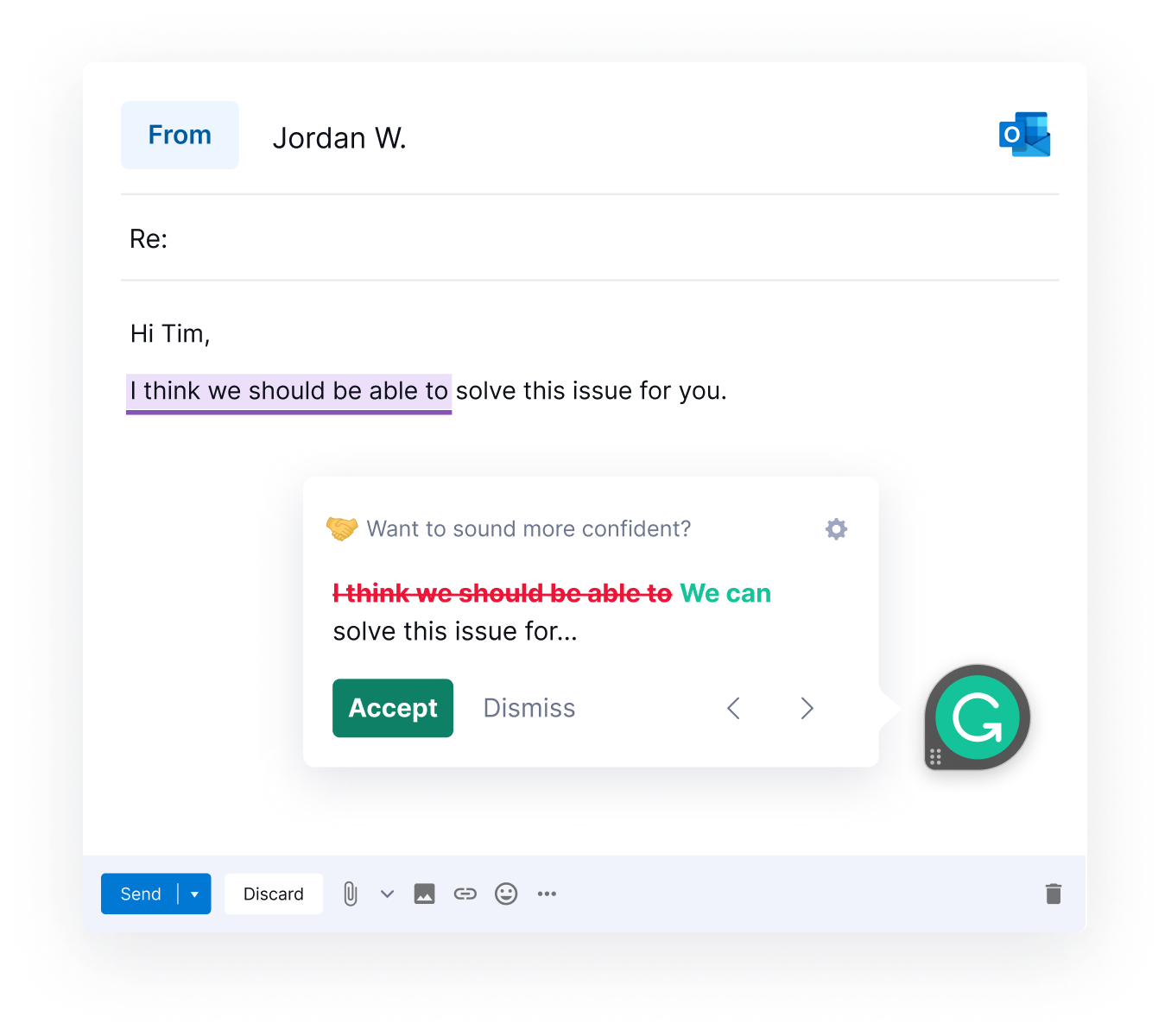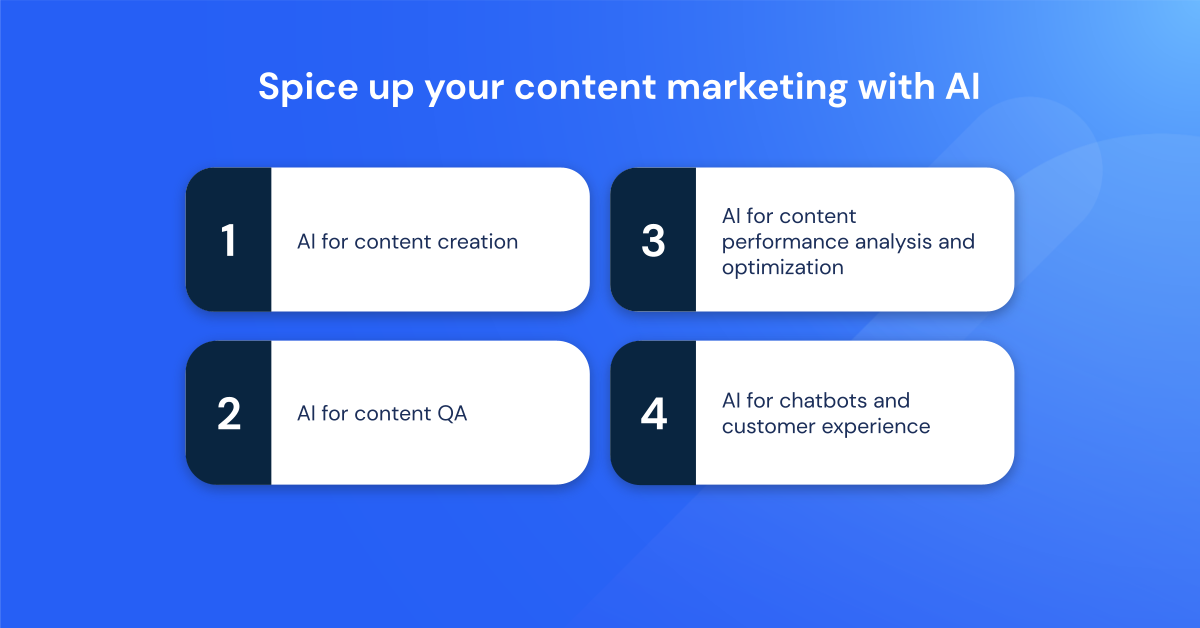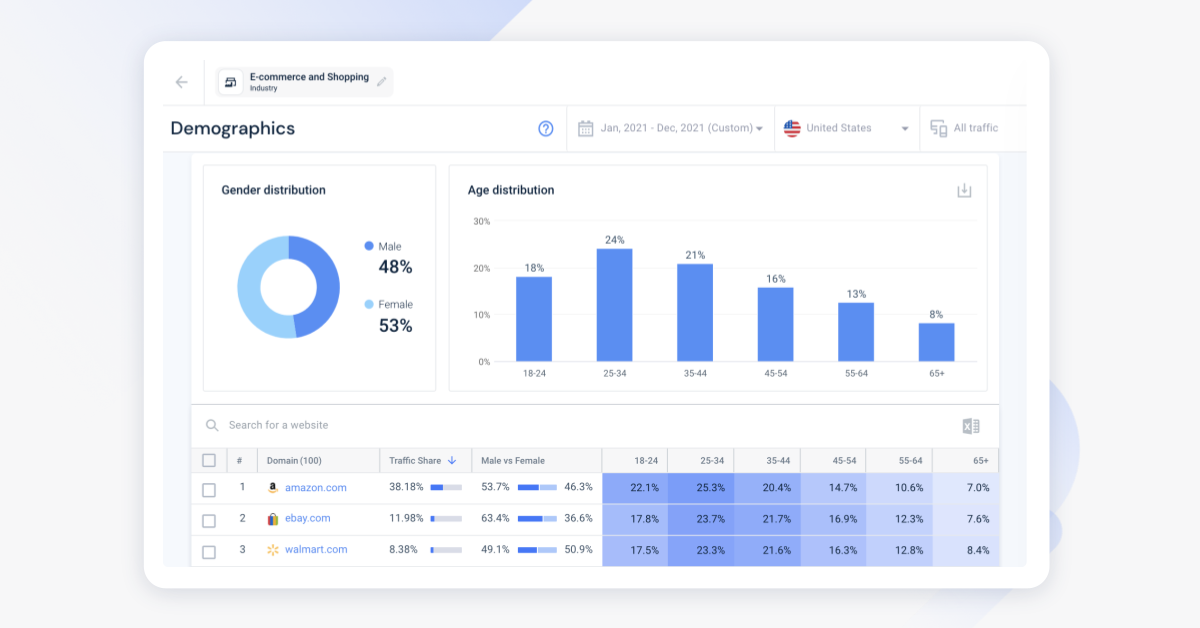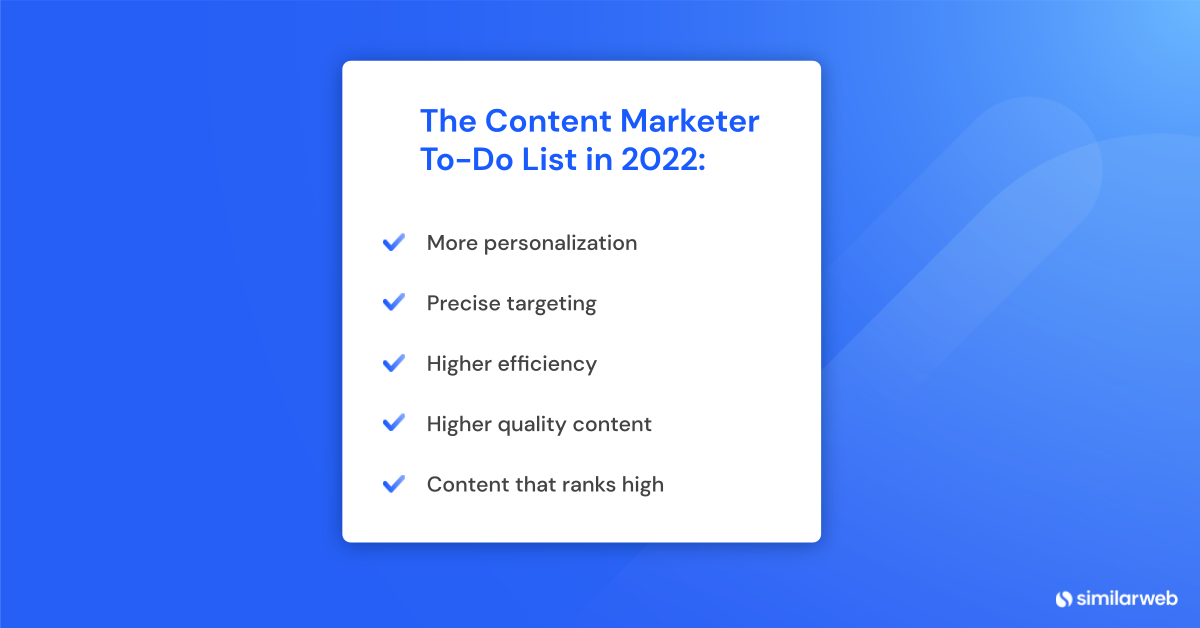Table of Contents
It definitely wasn’t love at first sight.
But artificial intelligence is gradually becoming a content marketer’s best friend – or at least more than an acquaintance.
It may turn into a love story yet and I believe we’re in for a “happily ever after” scenario.
If you don’t agree to the romance, I hear you.
But consider the stats.
The use of AI in marketing shows a 186% YoY growth.
Statistics show only 29% of marketing leaders used AI in 2018; by 2020, it was 84%.
Chatbots are particularly popular; usage increased by 92% between 2019 and 2020.
I understand why you’re skeptical.
All that buzz around AI creates the illusion we’re dealing with some supernatural hero.
Understandably, marketers are reluctant to let robotic heroes do their creative work.
I admit I’m one of them.
Only 15% of content marketers think about implementing AI more in 2022, according to the annual B2B Content Marketing Report by CMI (Content Marketing Institute) and MarketingProfs.
But wait, we just saw a tremendous increase in using AI in content.
So how does a low percentage for planning match the high rate of implementation?
I decided to look a little deeper into the use of AI for content marketing and discovered it’s useful in more ways than I imagined.
Read on and decide for yourself if this is a juicy romance or a passing fling.
How Do We Use AI In Our Daily Content Routine?
I won’t explain what AI is.
Others can do that much better.
I want to take a more practical approach and focus on what AI can and can’t do for content creation and marketing.
I’ll start by asking you a question: Are you aware of all the areas AI already supports your content marketing efforts?
It’s a lot more prevalent than you think.
Take Grammarly, for example.
The spelling and grammar checker has become standard in the content writing industry as a QA tool.
-
 Screenshot from Grammarly for desktop, January 2022
Screenshot from Grammarly for desktop, January 2022
Four years ago – remember the stats from 2018 – hardly anybody had heard of Grammarly.
Yet, few users today think of it as an AI tool and many aren’t even aware it uses AI.
And when everyone started using the spellchecker, no one declared, “Hey, let’s implement AI to double-check spelling and grammar.”
There are lots of tools like this in our daily routine, but we don’t give them much thought.
Google search results, keyword generators, email software, ad platforms – you get my point.
While we’re still philosophizing about the role of robots in our professional life, AI is already here, and, turns out, it’s no big deal.
Why The Fuzz Around AI In Content?
The old-fashioned cliche that robots are going to replace humans is alive and kicking – we’re afraid they’ll take away our jobs and turn the world into a technical matrix void of emotion and empathy.
The truth is, I agree with Ann Handley that robots and AI work for us and not the other way around.
Artificial brains learn what we want them to learn and carry out the tasks we train them to do.
So the debate whether or not to use AI for content revolves around the actual writing of content, the creative aspect of it.
Here’s a thought: What if writers exploited these tools to give them more time and scope for their creativity?
Once the right tools are adopted, AI software can take away quite a bit of the technical drudge and help writers improve the final outcome.
 Image from Similarweb, January 2022
Image from Similarweb, January 2022What Are Some AI Tools To Spice Up Your Content Marketing?
When you break down the content creation process, you can compare it to a production cycle that involves four main phases:
- Planning.
- Creating.
- QA/Testing.
- Analyzing/Optimizing.
Looking at it this way, I’m sure a bunch of AI-powered features come to mind more easily.
Let’s go into each stage to explore them.
AI For Content Planning
I’m a big fan of using smart tools to strategize.
You need marketing intelligence, and AI facilitates research data in every aspect.
I know firsthand from working at Similarweb, a company that specializes in web analytics.
It starts with your audience.
I benefit from our own audience analysis, keyword research, and ranking tools to help identify, understand, and target high-potential audiences.
-
 Screenshot from Similarweb, January 2022
Screenshot from Similarweb, January 2022
We also use MarketMuse for SEO recommendations and cross-check with our keyword research tool.
AI enables matching search terms with audience and industry.
Frase is an AI tool that crafts briefs based on SEO considerations and Google ranking factors.
Other AI-driven tools such as Cobomba and HubSpot can help you find trending topics.
You can then go back to your analytics and examine how your competition addresses them, what kind of content they publish, and how it performs.
AI For Content Creation
This is the hot potato, and I’ll address that in more detail below.
For now, let’s check what software tools in this space offer.
Most of you have heard of Jarvis, a tool that uses a GPT-3 OpenAI API to generate text and can potentially write your content for you.
It’s certainly not the only text generator out there and I’ll give you some more examples soon.
When it comes to turning numeric statistics into readable text, such tools may even come in handy. Automated Insights, for example, takes data and produces narratives for reports.
However, most content generation tools focus on a specific aspect of the creative process.
HyperWrite offers to rewrite your text according to your requirements, and Persado optimizes text by offering alternative highly-relevant vocabulary or phrases.
You can find many tools that suggest headlines, but Phrasee is probably the most popular.
Personyze and Concured help you personalize your landing pages and other marketing content.
AI For Content QA
I don’t need to mention Grammarly again. We all use it.
There are several other tools that check your language for quality, such as ProWritingAid, to name just one.
But correct language doesn’t guarantee your content will perform well, and there are a lot of other parameters AI can help you evaluate.
For example, to assess optimization for search engines, we use Clearscope.
Before a piece goes live, we run it through the system to help us predict how it will rank.
The tool analyzes the placement of keywords and other ranking factors and scores the content.
We also receive recommendations for improvement.
From one machine to another, artificial intelligence analyzes content for SEO and predicts the outcome, then helps you optimize.
All this for Google, another AI-powered tool, to read, rank, and deliver your content to searchers.
SEO isn’t the only factor worth assessing in content.
Acrolinx, for example, evaluates texts based on brand standards.
It’s used mainly by large corporations with many business units in different locations who need to create content with a unified message.
AtomicReach goes the extra mile to check your text for emotion, messaging, voice, or other qualities you may want to optimize.
Last but not least, AI can help you with your A/B testing.
Tools like Optimail enhance A/B testing for email marketing, while Evolve AI does the same for various assets.
AI For Content Performance Analysis And Optimization
At this stage, you’re circling back to the first stage.
Analytics tools typically employ AI one way or another to let you monitor performance and evaluate it.
Many of the same tools that help you strategize also help you optimize your content marketing continuously.
Chatbots
They aren’t directly related to content marketing, but we can’t leave them out of the content and AI discussion.
During recent months, boosted by stay-at-home restrictions, chatbots have gained enormous popularity, especially with eCommerce and online service providers.
-
 Screenshot from Tidio, Virtual Assistance Widget, January 2022
Screenshot from Tidio, Virtual Assistance Widget, January 2022
They’re no longer perceived as a nuisance spitting out overly standardized messages.
Chatbots can understand and address specific issues in a focused way and offer genuine assistance.
Some sound so genuinely human that they could pass for real people.
Chatbots have improved customer experience on countless sites, making customer service accessible 24/7 and providing immediate assistance wherever possible.
But there’s another benefit to chatbots.
They allow you to collect data on your audience.
This can improve your targeting, segmentation, and content personalization.
Is AI Smart Enough To Write Content?
Now for the big question.
Over the past three years, deep learning transformer models have spurred dramatic progress in AI’s ability to generate language. Now, unsurprisingly, the hottest thing in AI is language processing in general and language generation in particular.
But there are limitations.
If you’ve ever learned a foreign language, you know that understanding a sentence in a foreign language is relatively easy to learn.
Creating your own sentence is an entirely different ballgame.
Likewise, analyzing the style and meaning in a piece of writing and suggesting improvements is one thing; writing an authentic piece from scratch requires a completely different skill set.
It’s the difference between doing something with existing data and creating new data altogether.
Limitations To The Use Of AI With Language
Why is this important?
A robot is designed to perform tasks using large amounts of existing data according to structured, defined processes.
For all the language-related tasks, it means AI can:
- Understand.
- Analyze.
- Correct.
- Personalize.
- Suggest.
When it comes to generating text, AI tools can make relevant suggestions using scientific, mathematical formulas.
These can be based on SEO, brand voice, emotional parameters, professional level, the purpose of the content, etc.
However, language isn’t pure logic.
Creating language requires understanding the overall context and drawing on resources unavailable to the synthetic brain, such as culture, history, and other elements.
To reach and engage an audience, you need to come up with a catchy story that creates an associative connection in the reader’s brain.
You need to place it in an environment that triggers the emotions that engage the reader.
You could weave in an anecdote that resonates with a specific audience.
These are connections only a real-life human can forge properly.
I personally would not trust a machine to create content from scratch.
Do We Really Need AI For Content Creation?
Artificial Intelligence is here to make the content creation process faster, simpler, and more goal-focused.
We can use it to improve processes and the quality of outcomes.
Anything more would defy its purpose.
In addition, we need to remember that anything generated by an algorithm is a data-driven recommendation.
The final decision on which keyword to target, what topic to address, and where to place a comma stays the responsibility of a professional writer.
Nothing can replace the final human touch to get all the nuances right.
That may seem obvious, but unfortunately, I see more and more published texts obviously signed off by Grammarly instead of an editor.
For example, when a sentence reads “move onto” in place of “move on to”, it’s a sign that AI suggestions were not double-checked.
When a comma is misplaced and changes the meaning of a sentence because the robot didn’t understand, that’s when I start to worry.
It’s up to us to stay in control and not let synthetic brains dictate the quality of our content or writing.
How AI And Content Can Live Happily Ever After
Content in marketing has never been more important.
The pressure to produce more faster is increasing, but budgets aren’t.
 Image from Similarweb, January 2022
Image from Similarweb, January 2022Do you need more personalization? Yes.
Do you need more precise targeting? Yes.
Do you need higher efficiency? Yes.
Do you need higher-quality content? Yes.
Do you need your content to rank higher? Yes.
AI can help achieve these goals if you use it wisely and as long as you approach robots as what they are: Helpful tools.
Here’s another gem from CMI’s B2B Content Marketing Report. Look at what the most successful content marketers do that less successful ones don’t:
- They value creativity and craft.
- They care and pay attention to content details and messages.
- They think the entire customer journey through to make sure that every touchpoint connects to the adjacent ones and the message is consistent.
These are human traits. Embrace AI to make you faster and more strategic, but make sure you – the human – always have the final word.
More resources:
Featured Image: Jirsak/Shutterstock
https://www.searchenginejournal.com/ai-content-creation/436763/




